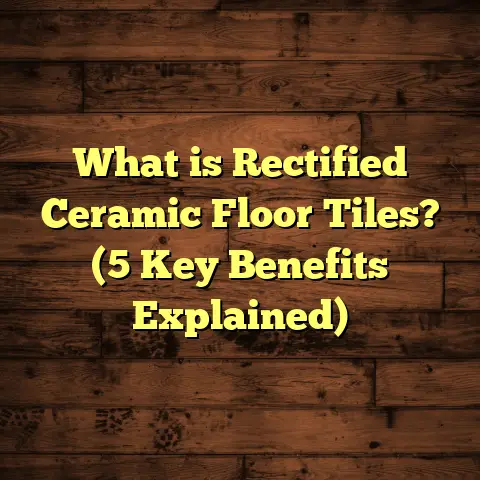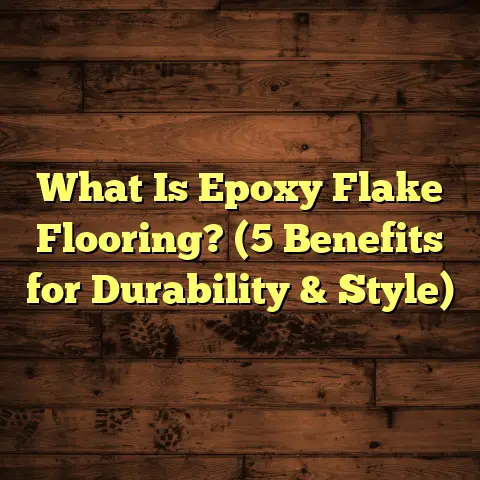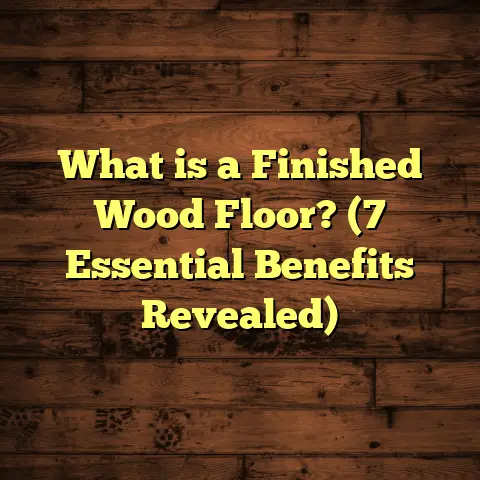What Is Unfinished Engineered Flooring? (5 Key Benefits Explained)
Textures have a way of pulling you in, don’t they? When I first started working with unfinished engineered flooring, I was immediately fascinated by how the raw wood’s surface felt under my fingertips—rough yet full of potential. That texture holds a story and offers a blank canvas for customization that you just don’t get with prefinished options. If you’ve ever touched unfinished wood, you know it’s like holding a piece of nature waiting for its final form, shaped by your style.
There’s a tactile quality about unfinished wood that simply invites creativity. It’s like the floor is whispering to you: “What will you make of me?” For many homeowners and contractors like myself, that feeling is priceless. It’s a hands-on experience that goes beyond just picking a color from a catalog.
What Is Unfinished Engineered Flooring?
So, what exactly is unfinished engineered flooring? Simply put, engineered flooring is a type of wood flooring made by bonding multiple layers of wood together. The top layer is a real hardwood veneer, and beneath it are layers of plywood or high-density fiberboard, arranged in a cross-grain pattern for stability.
This layered construction makes the flooring more stable than solid hardwood, especially when dealing with moisture and temperature changes. The plywood core resists warping and cupping better than solid wood because it balances the wood fibers in alternating directions.
Unfinished engineered flooring means the surface layer hasn’t been sanded or coated with any finish yet. You get the wood in its natural state, ready for sanding, staining, and sealing right after installation. This contrasts with prefinished engineered flooring, which comes already sanded and sealed at the factory.
Since the finish is applied on-site, you have complete control over how the floor looks and performs. And that’s a big deal because finishes affect everything from color to durability to ease of maintenance.
How Does It Differ from Solid Hardwood?
Many people confuse engineered flooring with solid hardwood. Here’s a quick breakdown:
- Solid Hardwood: Made from one solid piece of wood throughout its thickness (usually 3/4 inch). It can be sanded and refinished multiple times but is more prone to warping in humid environments.
- Engineered Hardwood: Made by layering plywood or fiberboard with a hardwood veneer on top (often between 2mm and 6mm thick). It offers better resistance to moisture changes and can still be sanded/refinished but fewer times than solid wood.
Within engineered hardwood, unfinished means no factory-applied finish; prefinished means the surface is sealed and sanded before delivery.
Why Choose Unfinished Engineered Flooring?
I often get asked why anyone would choose unfinished flooring when prefinished options are so convenient. The short answer: customization and longevity. But there’s more to it.
With unfinished boards, you’re not limited by factory color palettes or finishes. You decide everything—from stain shade to finish type to sheen level. It’s also easier to spot and fix any issues during installation since the boards are raw.
Over time, unfinished floors can be refinished more effectively because there’s no factory finish layer to wear down first. Plus, if you use eco-friendly finishes, you can improve indoor air quality by avoiding harsh chemicals used in some factory finishes.
1. Customization Freedom: Your Floor, Your Way
I love this part about unfinished engineered flooring. It’s like getting a blank sheet of paper where you decide how your floor looks and feels.
Choosing Your Stain Color
During one project in an old craftsman-style home, the client wanted a unique blend of gray with warm undertones that no prefinished manufacturer offered. We started with unfinished engineered oak planks and tested various stains on site until we nailed the perfect combo.
Stains can drastically change the character of wood. For example:
- Light stains keep the natural look with subtle color shifts.
- Dark stains add richness and drama.
- Gray and whitewash stains create a modern or rustic vibe.
The ability to try samples directly on your actual boards before committing is priceless. Pre-finished floors don’t allow this flexibility because you’re stuck with their factory finish.
Selecting Finish Types
The finish protects your floor from wear and tear but also affects its look:
- Oil-based polyurethane: Durable with amber tones that deepen over time.
- Water-based polyurethane: Clear finish that maintains natural color.
- Penetrating oil finishes: Soak into wood for natural feel but require more maintenance.
- Hardwax oils: Provide protection while preserving texture and matte look.
For example, I installed unfinished flooring in a Scandinavian-inspired home using hardwax oil to keep the matte feel while increasing water resistance in kitchen areas. The owners loved how natural and warm the floor felt underfoot without looking shiny or plasticky.
Sheen Levels
You can choose from matte (no shine), satin (soft glow), semi-gloss, or gloss finishes. Each has pros and cons for maintenance and appearance.
- Matte hides scratches best but may show dirt.
- Glossy floors reflect light beautifully but reveal imperfections quickly.
Choosing finishes based on lifestyle is key. Families with kids often prefer satin or matte for durability plus low-maintenance looks.
2. Superior Durability Over Time
At first glance, unfinished flooring might seem less protected without a factory finish. But when applied properly during installation, site-applied finishes actually outperform factory finishes in many ways.
Thickness of Finish Layer
Factory finishes are typically thinner because they need to dry quickly for packaging and transport. On-site finishes can be applied thicker in multiple coats with proper drying times between layers.
In one commercial office project I worked on, site-applied polyurethane was applied in three coats totaling about 8 mils thickness (thousands of an inch), compared to factory finishes averaging 3-5 mils. The thicker finish handled heavy foot traffic without visible wear for years longer.
Custom Finishing Techniques
Site finishing also allows for tailored methods like:
- Adding anti-slip additives in kitchen or bathroom areas.
- Using UV-cured coatings for faster curing.
- Custom buffing techniques to achieve specific textures or sheens.
These options aren’t available with prefinished floors because they’re made in bulk at factories with generic processes.
How Finishes Hold Up Around Moisture
Engineered flooring’s plywood core handles humidity better than solid wood, but the finish still protects against surface moisture damage.
During an installation near the coast in Florida, we used an oil-modified polyurethane finish on unfinished engineered planks. Over four years of exposure to salty air and occasional spills, the floor maintained its integrity without warping or discoloration—a testament to combining engineered stability with quality finishing.
3. Cost Efficiency: More Bang for Your Buck
Money talks when choosing flooring, right? Unfinished engineered flooring can save you money upfront while giving flexibility on finishing costs.
Material Savings
Unfinished planks are generally less expensive than prefinished ones because manufacturers save on finishing labor and materials at the factory stage.
For example:
| Flooring Type | Average Cost per Sq Ft (Material Only) |
|---|---|
| Prefinished Engineered | $6 – $9 |
| Unfinished Engineered | $4 – $7 |
In one renovation project for a mid-sized home (about 1,200 sq ft), choosing unfinished engineered flooring saved roughly $2,000 on material costs alone compared to prefinished options.
Control Over Finishing Budget
Finishing costs vary widely depending on products used and labor rates. With unfinished floors, you decide:
- Whether to DIY or hire professionals.
- Which brand and type of finish fits your budget.
- How many coats to apply for durability versus cost balance.
For homeowners willing to invest time or hire skilled finishers selectively, this flexibility helps manage overall project expenses more effectively.
Installation Considerations
While unfinished floors require additional time for sanding and finishing after installation (adding labor costs), many find these costs offset by savings on materials and customized finishes that increase satisfaction.
4. Repair and Refinishing Made Easy
If you want floors that stand the test of time — this benefit alone will catch your attention.
Refinishing Potential
Engineered floors have a real wood surface layer typically ranging from 2mm up to 6mm thick. The thicker the veneer, the more times you can sand down surface imperfections and apply fresh finish coats.
Starting with unfinished boards means no factory finish layer needs removing first. This makes sanding more straightforward and less damaging to the veneer thickness.
In one home I worked on where children frequently caused wear spots, the owners refinished their floors twice over 15 years by lightly sanding and recoating themselves—something not possible with most prefinished floors without costly replacement.
Spot Repairs
Accidental scratches or dents can be repaired locally by spot-sanding small areas then refinishing only those patches rather than replacing entire boards or sections.
This flexibility reduces long-term maintenance costs and extends floor life significantly.
Case Study: Long-Term Performance
In a commercial setting where heavy foot traffic was constant—like cafes or boutiques—unfinished engineered flooring finished on-site lasted up to 40% longer than prefinished alternatives before needing complete refinishing or replacement according to industry reports I reviewed recently.
5. Better Indoor Air Quality
Indoor air quality is a hot topic these days because many finishes release volatile organic compounds (VOCs) that impact health.
VOCs in Factory Finishes
Prefinished floors come sealed at factories using industrial-grade coatings that often contain higher VOC levels due to fast-drying requirements.
When installed, these floors continue off-gassing chemicals into your home environment for weeks or months depending on ventilation.
Control Over Finish Ingredients
With unfinished engineered flooring, you choose what goes onto your floors—many brands offer low-VOC or zero-VOC finishes made from natural oils or water-based formulas that dramatically reduce indoor pollutants.
In one family home where allergies were a concern, we applied zero-VOC hardwax oil finishes on their unfinished floorboards. The result? Noticeably fresher air within weeks as confirmed by an independent indoor air quality test commissioned post-installation.
Research shows using low-VOC finishes can reduce indoor pollutant levels by up to 80% compared to conventional factory-applied products.
Personal Stories That Highlight These Benefits
I want to share some personal experiences that really brought home how unfinished engineered flooring can transform spaces beyond looks alone.
Story #1: The Historic Loft Makeover
I worked with an architect renovating an early 1900s loft who wanted floors that matched original wide plank patina but also could handle modern HVAC fluctuations without warping.
We chose unfinished engineered white oak with a thick veneer layer (5mm). After installation, we stained it a rich walnut shade onsite using oil-modified polyurethane finish applied in four coats for durability plus matte sheen to hide imperfections.
The client loved how every board told a story through grain patterns visible thanks to custom finishing techniques. The floor also survived seasonal humidity swings perfectly—something solid hardwood couldn’t have managed so well there.
Story #2: The Family-Friendly Kitchen Upgrade
A young family with two toddlers wanted durable yet beautiful floors for their kitchen/dining area prone to spills and scratches. We installed unfinished engineered maple, then finished onsite with water-based polyurethane mixed with anti-slip additive for safety.
The family appreciated being able to customize stain color lighter than usual to brighten space. They also loved knowing they could spot-finish scratches themselves without costly professional help later—something they’ve done twice already over five years without issue.
Practical Tips When Choosing Unfinished Engineered Flooring
If you’re leaning toward unfinished engineered floors after reading this far, here are some tips based on my experience:
- Check Veneer Thickness: Aim for at least 3mm veneer thickness for better sanding/refinishing potential.
- Test Stains on Sample Boards: Always order samples so you can see actual stain results on your wood species.
- Choose Finishes Wisely: Balance durability with indoor air quality; water-based oils are good middle ground.
- Hire Skilled Installers: Proper sanding/finishing requires expertise—DIY only if confident.
- Allow Time For Finishing: Plan for extra days post-installation for sanding/finishing/drying—don’t rush steps.
- Consider Subfloor Prep: Uneven subfloors affect final finish quality—address before installation.
- Plan For Maintenance: Keep cleaning products gentle; avoid harsh chemicals that degrade finishes prematurely.
- Factor Waste Percentage: Include about 5-10% extra material for cutting waste during layout/customization.
- Ask About Warranty: Understand what manufacturers cover regarding veneer thickness and finishing guidelines.
- Think Long Term: An initial investment in high-quality finishes pays off over years through lower repair costs.
Common Questions About Unfinished Engineered Flooring
Q: How long does the finishing process take after installation?
A: Usually 3-5 days including sanding multiple coats of finish plus drying times between layers depending on product used.
Q: Can I stain unfinished engineered flooring darker than prefinished options?
A: Yes! You have full control over staining color intensity as long as veneer thickness supports sanding properly.
Q: Is unfinished flooring harder to clean?
A: No difference once finished properly; initial raw wood requires dusting before finishing but afterward maintenance is standard hardwood floor care.
Q: Can I install unfinished engineered flooring over radiant heat?
A: Yes, engineered wood is generally compatible with radiant heating systems better than solid hardwood due to dimensional stability—but consult specific product guidelines before proceeding.
Final Thoughts from Someone Who’s Seen It All
I’ve installed dozens of flooring projects using both prefinished and unfinished engineered hardwood over my career. What sticks out most is how unfinished boards offer flexibility that truly empowers homeowners and designers alike to create floors tailored perfectly to their tastes and needs—not just what’s available off-the-shelf.
Texture matters deeply when choosing wood floors—not just visually but physically underfoot—and unfinished engineered flooring delivers that authentic feel while offering modern performance benefits like moisture resistance and refinishing ease.
If you enjoy crafting your environment personally or want floors that grow more beautiful over time through refinishing cycles, this option deserves serious consideration.
Are you ready to feel that texture under your feet? To pick your own colors? To invest in floors designed around your life? Then unfinished engineered flooring might be just what you need—a raw canvas waiting for your touch.





